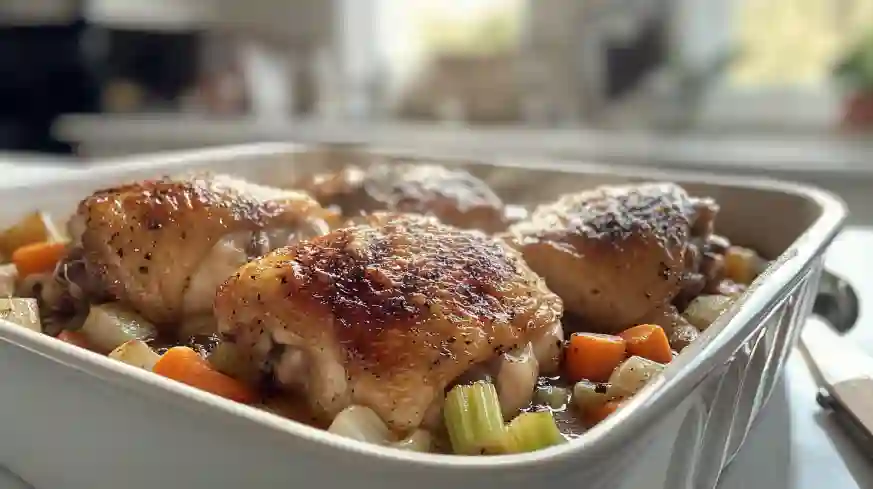Chicken thighs often fly under the radar in favor of flashier cuts like breasts or wings, but ask any seasoned cook and they’ll tell you: thighs pack the most flavor. Juicy, tender, and incredibly affordable, chicken thighs are a budget-friendly staple that can elevate everyday meals with their rich taste and satisfying texture.
Boiling chicken thighs might not sound glamorous, but it’s one of the most reliable and healthiest cooking methods available. Whether you’re a beginner in the kitchen or a busy home chef looking for convenience, boiling offers an easy, hands-off approach that yields consistently moist and flavorful meat every time. Plus, the broth you create in the process can be reused, making it both sustainable and delicious.
Across cultures, boiled chicken is a culinary chameleon—appearing in comforting soups, hearty rice dishes, refreshing salads, and even spicy tacos. Growing up, I watched my mother simmer chicken thighs for her famous chicken noodle soup, and now I find myself relying on the same technique for weekly meal prep.
Beyond taste and versatility, boiled chicken thighs offer solid nutrition. They’re rich in protein, iron, and zinc, and boiling reduces fat without sacrificing moisture—making it a heart-healthy alternative to fried or grilled options.
How Long to Boil Chicken Thighs
Course: DinnerCuisine: AmericanDifficulty: Medium4
servings10
minutes30
minutes250–300 kcal per serving
kcalTender, juicy chicken thighs boiled to perfection with herbs, aromatics, and rich flavor.
Ingredients
4 chicken thighs (bone-in or boneless, skin-on or skinless)
6 cups water (or low-sodium chicken broth for more flavor)
1 teaspoon salt
½ teaspoon black pepper
1 onion, quartered
3 garlic cloves, smashed
2 bay leaves
1 teaspoon dried thyme (or a few fresh sprigs)
2 celery stalks, chopped
1 carrot, chopped
Optional: 1 tablespoon apple cider vinegar (helps extract flavor for broth)
Directions
- Prepare the Ingredients
Rinse the chicken thighs under cold water. Pat them dry with paper towels. Roughly chop the onion, carrot, and celery. - Add to Pot
Place the chicken thighs in a large pot. Add water (or chicken broth) until the chicken is fully submerged. Add salt, pepper, onion, garlic, bay leaves, thyme, carrot, and celery. - Bring to a Boil
Turn the heat to high and bring the pot to a rolling boil. - Skim the Foam
Once it starts boiling, use a spoon to skim off any foam or impurities that rise to the top. This keeps your broth clear and clean-tasting. - Reduce Heat & Simmer
Lower the heat to medium-low to maintain a gentle simmer. Cover loosely with a lid.
Boneless thighs: simmer for 15–20 minutes
Bone-in thighs: simmer for 25–30 minutes - Check for Doneness
Use a meat thermometer to ensure the internal temperature reaches 165°F (74°C). The meat should be opaque and easy to shred. - Remove & Rest
Use tongs to remove the chicken thighs from the pot. Let them rest for 5 minutes before serving or shredding. - Optional – Strain the Broth
If you’re making broth, strain the liquid and store it separately for soups or sauces.
Table of Contents
Essential Ingredients for Perfectly Boiled Chicken Thighs
When it comes to boiling chicken thighs, simplicity is key—but that doesn’t mean you have to compromise on flavor. Below is a detailed guide to the core ingredients, flavorful add-ins, and smart substitutions that will help you craft a delicious and nourishing dish every time.
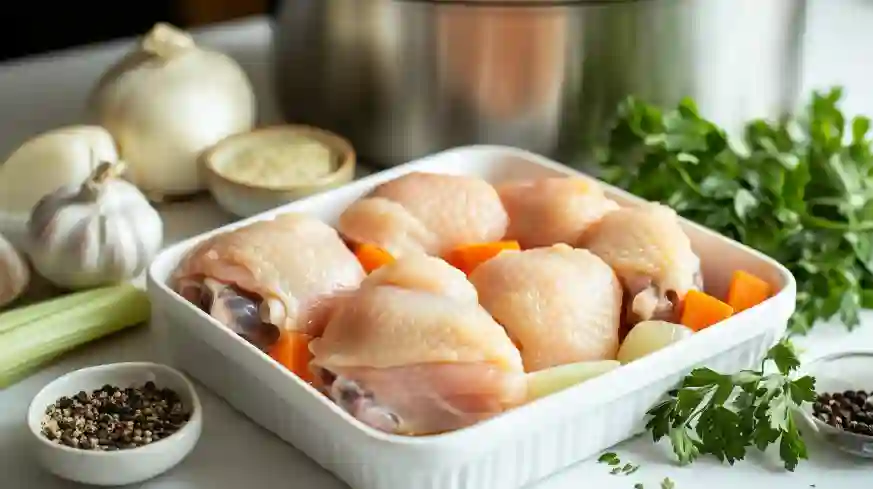
Core Ingredients
- Chicken Thighs: Choose between bone-in or boneless, skin-on or skinless, depending on your preference. Bone-in thighs tend to yield richer flavor, while skinless options are leaner.
- Water or Broth: Enough to fully submerge the chicken. Use low-sodium chicken broth for added depth.
- Salt: Start with a teaspoon and adjust to taste. Salt enhances the natural flavor of the chicken.
- Black Pepper: Freshly cracked pepper adds a subtle kick.
- Aromatics:
- Garlic Cloves (2–3, smashed)
- Onion (1, halved or quartered)
- Bay Leaf (1–2)
- Fresh Parsley and Thyme (a few sprigs each)
Optional Flavor Boosters
- Lemon Slices: Add brightness and balance.
- Fresh Ginger: Offers warmth and depth, especially in Asian-inspired dishes.
- Whole Peppercorns: For an earthy, complex flavor profile.
Substitutions & Variations
- Vegetable Broth: Ideal for vegetarians or if you want a different flavor profile.
- Other Cuts: Chicken breasts or drumsticks also work well with the same method.
- Plant-Based Chicken: For a vegetarian version, simulate the process using soy or wheat protein-based “chicken” in a veggie broth with aromatics.
Tips for Best Results
- Opt for fresh, organic chicken for better texture and cleaner flavor.
- Leave the bone in to enrich the broth, especially if you’ll be using it later.
- Trim excess fat or skin before boiling for a leaner, cleaner result.
How to Boil Chicken Thighs to Juicy, Flavorful Perfection: Step-by-Step Instructions
Boiling chicken thighs is not just about cooking meat—it’s about coaxing out deep, comforting flavors and achieving tender, pull-apart perfection with minimal fuss. Here’s a detailed guide to help you master the method, step by step.
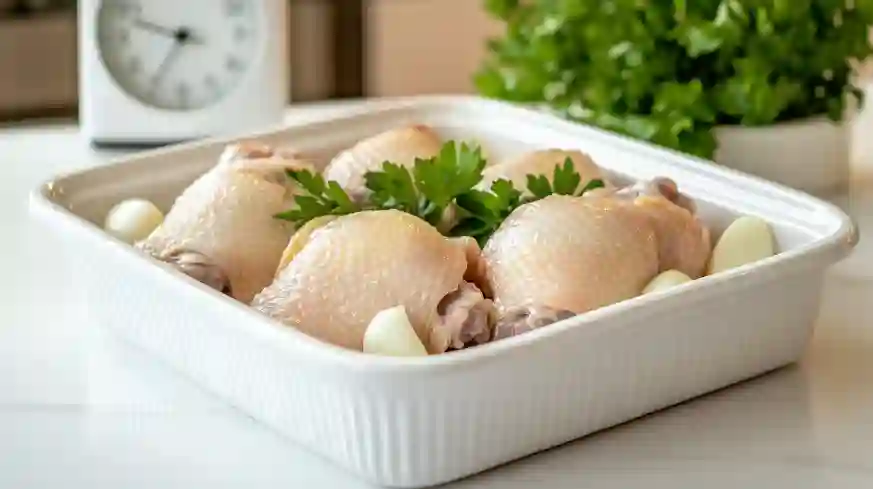
Step 1: Prep the Chicken
Start with clean, fresh chicken thighs. Rinse them briefly under cold water, then pat them completely dry using paper towels. This helps the seasoning adhere and prevents excess water from diluting your broth. Season the thighs lightly with salt and freshly cracked black pepper. Don’t worry about heavy seasoning here—the aromatics in the pot will infuse rich layers of flavor.
Tip: If you’re using skin-on thighs, consider trimming off any excess fat for a cleaner, lighter broth.
Step 2: Place Chicken in Pot
Arrange the chicken thighs in a single layer at the bottom of a large, heavy-bottomed pot. Avoid stacking to ensure even cooking. This setup allows the heat and flavors to circulate around each piece fully.
Step 3: Add Liquid and Aromatics
Pour enough water or broth into the pot to fully submerge the chicken. For a richer, more savory taste, opt for low-sodium chicken or vegetable broth.
Next, toss in your aromatics:
- A few smashed garlic cloves for warmth
- One quartered onion for sweetness
- A bay leaf or two for depth
- A handful of fresh herbs like parsley and thyme for an herbal lift
You can also add lemon slices, ginger, or whole peppercorns to tailor the flavor profile.
As the liquid heats, the aroma of garlic and onion begins to rise—a comforting scent that signals homemade goodness is on the way.
Step 4: Bring to a Boil
Place the pot on the stove over medium-high heat and bring the liquid to a rolling boil. This should take about 8–10 minutes. You’ll notice a light foam forming on the surface—this is natural.
Tip: Skim off the foam with a spoon for a cleaner, clearer broth, especially if you plan to use it later in soups or sauces.
Step 5: Reduce Heat and Simmer
Once the pot is boiling, reduce the heat to low, cover with a lid, and allow the chicken to simmer gently.
- Boneless chicken thighs: Simmer for 15 to 20 minutes
- Bone-in thighs: Simmer for 25 to 30 minutes
You’ll notice the meat becoming opaque and incredibly tender, while the broth develops a rich, golden hue.
Step 6: Check for Doneness
To ensure the chicken is fully cooked, insert a meat thermometer into the thickest part of a thigh. The internal temperature should read 165°F (74°C). If you don’t have a thermometer, slice into one piece—the juices should run clear, not pink.
Step 7: Remove and Rest
Using tongs or a slotted spoon, transfer the chicken to a clean plate or cutting board. Let it rest for 5 minutes—this step locks in moisture and makes slicing or shredding easier.
You’re now ready to use your perfectly boiled chicken thighs in tacos, salads, soups, or rice bowls—or simply enjoy them as they are, tender and full of comforting flavor.
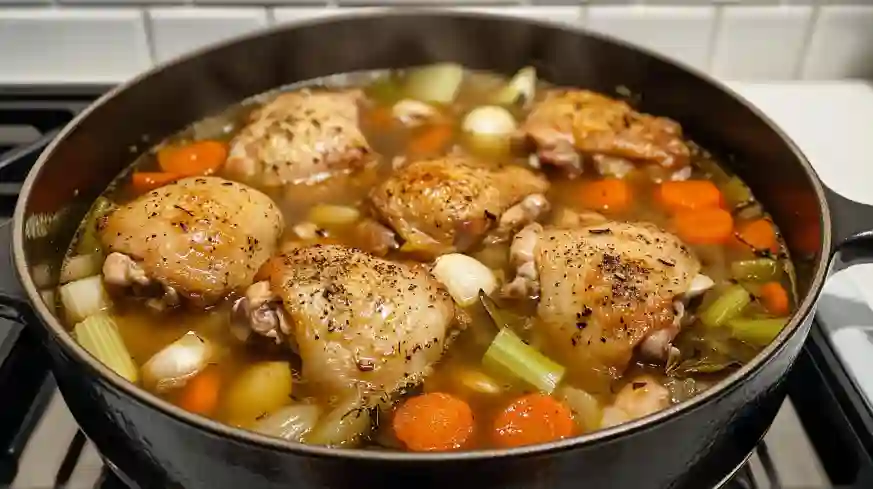
Tips & Variations for Making the Most of Boiled Chicken Thighs
Boiled chicken thighs are more than just a one-note protein—they’re a culinary chameleon that fits a variety of diets, dishes, and cooking styles. Whether you’re cooking for specific health needs or looking to batch prep for the week, these tips and variations will help you maximize both flavor and functionality.
Diet-Friendly Options
Low-Sodium:
If you’re watching your sodium intake, skip the salt and use unsalted broth or plain water as your base. Enhance flavor naturally with aromatics like garlic, onion, parsley, and thyme. You’ll still get a deliciously savory outcome without the extra sodium.
Keto/Paleo:
Boiled chicken thighs are ideal for low-carb, high-protein diets. For keto, the fat in skin-on thighs can be beneficial—but if you’re aiming for a leaner paleo approach, simply remove the skin and trim the fat before cooking.
Flavor Boosts to Customize Your Broth
- Add soy sauce or a spoonful of miso paste for a savory umami kick—perfect for Asian-inspired meals.
- Stir in red curry paste, lemongrass, or ginger to create a Thai-style broth.
- Go Mediterranean with dried oregano, lemon slices, and olive oil, giving your chicken a fresh, herbal profile.
- Want a warming touch? A pinch of smoked paprika or cumin will do the trick.
These flavor additions seep into the chicken during simmering, enhancing both the meat and the broth for future use.
Don’t Discard the Broth—Use It Wisely
The leftover broth is liquid gold. It’s infused with nutrients, collagen (especially from bone-in thighs), and aromatic depth. Strain and store it in a jar or freeze in portions to use for:
- Soup bases
- Cooking rice or quinoa
- Homemade sauces or gravies
Serving Suggestions
- Shred and mix with salsa or hot sauce for tacos, burritos, or enchiladas.
- Slice and layer into sandwiches, grain bowls, or refreshing cold salads.
- Serve whole, paired with roasted vegetables or steamed greens for a balanced, wholesome plate.
Batch Cooking & Freezing Tips
Boil a large batch at once and portion into meal-sized containers. Refrigerate for up to 4 days or freeze for up to 3 months. Always cool the chicken completely before sealing to maintain quality and moisture.
Pro Tip: Freeze the broth in ice cube trays—perfect for quick flavor boosts in stir-fries or sautés.
With these tips and variations, boiled chicken thighs can easily become your go-to foundation for healthy, satisfying meals all week long.
Nutritional Information: Why Boiled Chicken Thighs Are a Smart, Healthy Choice
Boiled chicken thighs, especially skinless, strike the perfect balance between flavor and nutrition. They’re rich in high-quality protein, moderately low in fat, and contain virtually no carbohydrates—making them suitable for a wide range of diets from low-carb to heart-healthy.
Here’s a detailed nutritional breakdown per 100g of skinless, boiled chicken thigh:
| Nutrient | Value (per 100g) |
|---|---|
| Calories | 180 kcal |
| Protein | 24 g |
| Total Fat | 8 g |
| Carbohydrates | 0 g |
| Cholesterol | 90 mg |
| Sodium (no added) | ~70 mg |
Health Benefits
- High Protein Content: With 24g of protein per 100g, boiled chicken thighs support muscle repair, satiety, and immune function.
- Lower Fat from Boiling: Boiling allows excess fat to render into the broth, resulting in a leaner final product compared to frying or sautéing.
- Hydrating, Nutrient-Rich Broth: The leftover broth is loaded with collagen, electrolytes, and minerals—great for gut health and hydration.
Skin-On vs. Skinless Differences
Choosing skin-on thighs will slightly increase the calorie and fat content. For example:
- Calories: ~220 kcal
- Fat: ~13g
However, skin-on thighs deliver more flavor and can be useful in richer dishes.
In contrast, skinless thighs are better for those aiming for a leaner, heart-healthy diet, while still offering excellent taste and texture.
Common Mistakes When Boiling Chicken Thighs (And How to Fix Them)
Even though boiling chicken thighs is a relatively simple process, a few common missteps can turn a potentially delicious meal into a disappointing one. Here’s how to avoid the most frequent mistakes and make sure your chicken turns out tender, flavorful, and food-safe every time.
1. Overboiling the Chicken
Problem: Overcooking leads to a dry, rubbery texture that lacks the juiciness you expect from chicken thighs.
Fix: Stick to the correct simmering times—15–20 minutes for boneless, 25–30 minutes for bone-in—and always maintain a gentle simmer rather than a rolling boil.
2. Undercooked Chicken
Problem: Undercooked chicken poses serious food safety risks, including bacteria like Salmonella.
Fix: Use a meat thermometer to confirm the internal temperature reaches 165°F (74°C). Always test the thickest part of the meat.
3. No Flavor
Problem: Boiling chicken in plain water results in bland meat and broth.
Fix: Enhance your cooking liquid with aromatics like garlic, onion, bay leaf, herbs, and even citrus or ginger. Using broth instead of water adds another layer of richness.
4. Cloudy Broth
Problem: A cloudy, murky broth often results from boiling too aggressively.
Fix: Start with a gentle boil, then reduce to a simmer. Skim any foam or impurities that rise to the surface during the first few minutes for a clearer, more appealing broth.
5. Skin Falling Apart
Problem: If you’re using skin-on thighs for extra flavor or presentation, rough cooking can cause the skin to separate and disintegrate.
Fix: Keep the simmer low and avoid stirring too much. Gentle handling helps preserve the skin’s integrity.
By mastering these small adjustments, you’ll get consistently great results every time you boil chicken thighs.
Frequently Asked Questions About Boiling Chicken Thighs
Boiling chicken thighs is one of the easiest and most versatile cooking methods, but if you’re new to it—or just want to optimize your results—these common questions and expert answers will help.
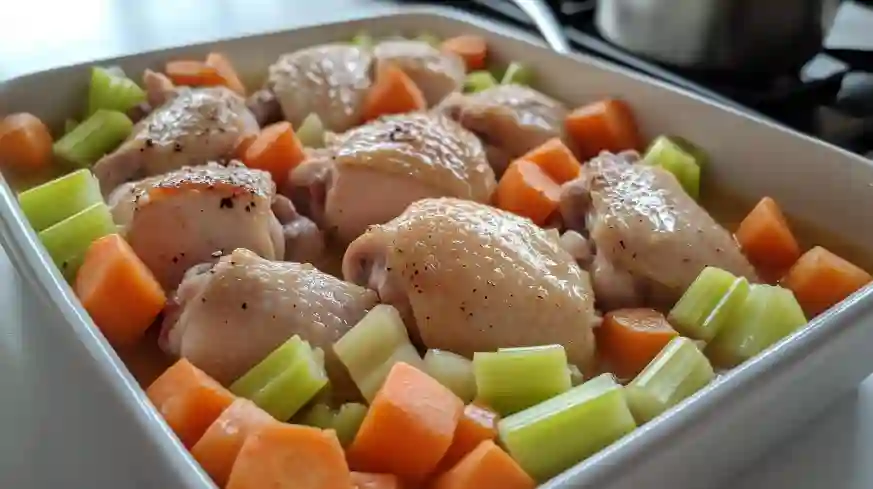
How long does it take to boil chicken thighs?
- Boneless thighs take about 15–20 minutes
- Bone-in thighs take around 25–30 minutes
Always simmer gently and use a thermometer to confirm the internal temperature reaches 165°F (74°C).
Can I boil them frozen?
Yes, you can boil chicken thighs straight from frozen. Just increase the cooking time by 10–15 minutes and ensure the thickest part of the meat hits 165°F before serving. Avoid stacking frozen pieces to ensure even cooking.
Can I prepare boiled chicken ahead of time?
Absolutely! Boiled chicken is ideal for meal prepping:
- Store in the refrigerator for up to 3–4 days
- Freeze for up to 3 months in airtight containers
Tip: Shred or slice before freezing for easy portioning later.
What’s the best use for boiled chicken?
Boiled chicken thighs are incredibly versatile:
- Toss into chicken salad or pasta
- Shred for tacos, enchiladas, or burrito bowls
- Dice and stir into soups, casseroles, or even stir-fries
Their tender texture and neutral flavor make them a flexible base for countless meals.
Can I reuse the broth?
Yes, and you should! The broth left after boiling is rich in nutrients and flavor. Strain it through a fine mesh sieve and refrigerate or freeze. It’s perfect for:
- Soup bases
- Cooking grains like rice or quinoa
- Sauces and gravies
It’s a sustainable, flavorful bonus from a simple cooking method!
Conclusion: Why Boiled Chicken Thighs Should Be a Kitchen Staple
Boiling chicken thighs is a simple, foolproof method that delivers on flavor, nutrition, and convenience. Whether you’re a busy parent, meal prepper, or someone just looking to eat healthier, this technique offers a reliable way to cook tender, juicy chicken with minimal effort.
Not only is it one of the healthiest ways to enjoy this flavorful cut—thanks to lower fat content and no need for added oils—but it’s also incredibly versatile. From nourishing soups to protein-packed salads, comforting rice dishes, and quick tacos, boiled chicken adapts beautifully to nearly any meal plan or cuisine.
Don’t be afraid to get creative! Try different aromatics like lemongrass, curry paste, or oregano to bring new global flavors into your kitchen. Whether you’re simmering for family dinners or stocking your freezer for the week, boiled chicken thighs are a must-have recipe in your repertoire.
We’d love to hear from you!
💬 What did you use your boiled chicken for? Did you experiment with any flavor twists? Drop your ideas and feedback in the comments!
🔗 Related Recipes You’ll Love:

